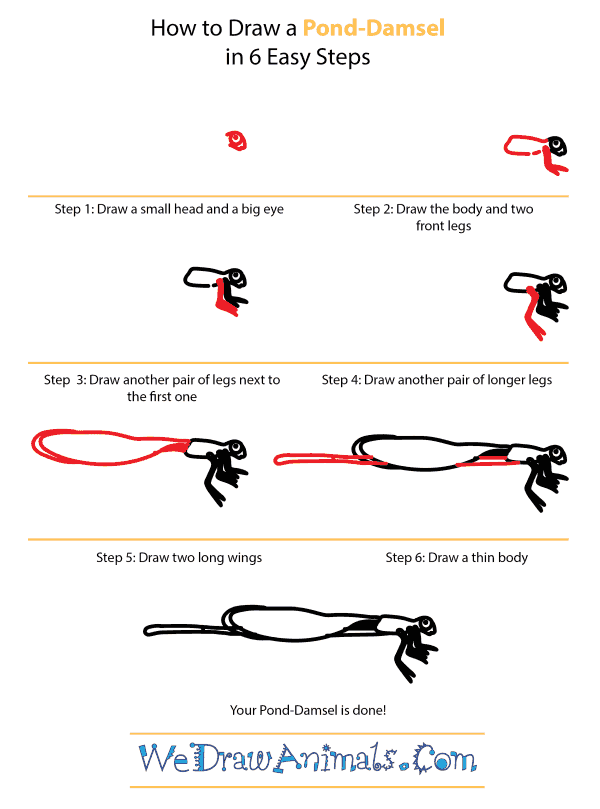In this quick tutorial you'll learn how to draw a Pond Damsel in 6 easy steps - great for kids and novice artists.
The images above represent how your finished drawing is going to look and the steps involved.
Below are the individual steps - you can click on each one for a High Resolution printable PDF version.
At the bottom you can read some interesting facts about the Pond Damsel.
Make sure you also check out any of the hundreds of drawing tutorials grouped by category.
How to Draw a Pond Damsel - Step-by-Step Tutorial
Step 1: Draw a small, rounded head and a large beady eye (will almost take up whole head)
Step 2: Draw a small, potato shape behind the head to start the body, add two small legs at the "neck" also
Step 3: Draw another pair of legs directly behind the first
Step 4: And a third pair of legs behind that. Make them a bit longer though
Step 5: Draw two long, thin, oval like wings
Step 6: A very thin body is drawn underneath that
Interesting Facts about the Pond-Damsel
This unique dragonfly is part of a family called the damselfly. It has other nicknames including the common orange, common citril and orange waxtail. They are widely distributed all throughout Africa, making their homes near almost any kind of water source that they can find. There are over 1,100 species of damselflies, all of which are commonly referred to as the narrow-winged dragonfly. Their wings are clear, and males tend to have orange and green bodies. The bodies of females are far less flashy, with their coloring ranging between dark and light brown, depending on its stage in maturity. They are a predatory species, often eating other insects that inhabit the same environments as they do.
Did you know?
- Immature pond damsels will molt several times, the final time being when they emerge from the water to grow into adults.
- When this happens, the nymph’s skin will split down the back and they will emerge from their skin with a newly inflated body and wings.
- In wet-fly fishing, the lures that are often used strongly resemble the nymph of this species.
- The pond damsel is also a common and popular design for jewelry pieces.
- Water fleas seem to make up most of their diet, as they find them frequently while hovering over grasses near or on water. The pond damsel will snatch them right out of the air to eat them.
- The pond damsel is one of the smallest species of dragonfly.
Arts and Crafts Activity Notes: Draw the pond damsel. Proceed to make and distribute copies for each participant in the activity, and then instruct them to color in their dragonflies with colored pencil, marker or crayon. After that is done, have them cut the finished result out of the paper, and set it aside for now. Retrieve popsicle sticks and glue or tape that will be used to fix the paper insect to the stick, and proceed to do so. Once all of the pond damsels are finished and attached to their sticks, you can then plant them in the ground near a source of water. If you don’t have a natural water source nearby, you can improvise with aquarium rocks or sand and a small tank. Now you’ll have your own pretty display of colorful pond damsels!







